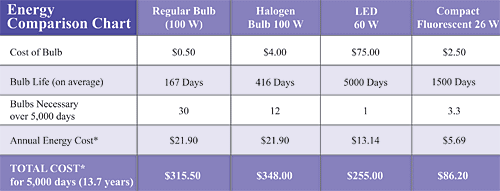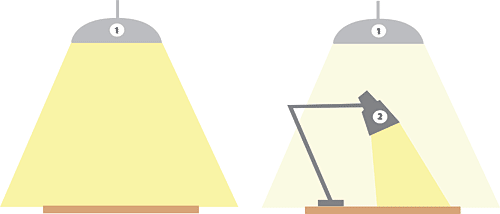Task Lighting Solutions: Their Economic and Ergonomic Benefits
|
Task Lighting Saves Energy
A task light using a 26-watt compact fluorescent lamp will consume far less energy to illuminate a work area than will a typical overhead lighting fixture. A work environment can maintain lower levels of overhead lighting by illuminating desktops with energy-efficient task lights. In addition, maintenance and bulb replacement costs are less with task lighting. An Ernest Orlando Lawrence Berkeley National Laboratory 2003 study for the U.S. Department of Energy on Task Ambient Office Lighting concluded that "comparative analyses indicate significant energy and cost savings through separation of ambient and task lighting systems, as high as 60 percent for energy and almost 50 percent for life cycle cost."
|
According to the California Energy Commission, lighting accounts for 23 percent of the electricity used in the state. The actual figure may be considerably higher, say other sources. Five percent of electricity used for air conditioning, for example, goes to eliminate heat generated by lighting. In general, however, the EPA estimates that lighting accounts for 20−25 percent of the electricity used annually in the United States. This suggests that overall energy use can be reduced by more than 10 percent with the introduction of an energy-efficient task-ambient lighting scheme featuring fluorescent technology. One encouraging sign is a recently introduced U.S. Senate bill that proposes a phase-out of incandescent lamps by 2012.
Task Lighting and LEED®
With clients' growing requirements for energy efficiency and the 2,000 percent explosion in USGBC membership, expertise in lighting systems and how they can impact LEED®-CI certification has become a competitive edge.
There are several categories where task lighting can help achieve points. They include:
Indoor Environmental Quality. Providing task lighting for 90 percent of employees may earn a point for controllability of systems.
Materials and Resources. Recycled content of lights and fixtures can contribute significantly to one or two points in the category.
Energy and Atmosphere. Energy use of both ambient and task lighting must be calculated to meet LEED requirements for varying percentages below ASHRAE 90.1−2004 standards (under California's Title 24 Energy Efficiency Standards, the most rigorous in the country, the maximum is one watt per square foot). One challenge in this category is achieving points for a retro fit of an existing building with a traditional overhead fluorescent layout using 1.4 watts per square ft. Designers have solved the problem by removing overhead fixtures and adding low energy task lights, which will ultimately provide a better lighting solution for the occupants.
Francis Rubinstein, Staff Scientist at the Lighting Research Group, Lawrence Berkeley National Laboratory, suggests a different approach: Install overhead lighting that uses one watt per sqare foot, but build in controls and occupant sensors that turn off lights when not in use (a possible gain of one point in the Energy & Atmosphere category).
This will reduce energy use to 0.6 or 0.7 watts per square foot, thereby leaving an energy allowance for task lights.
Innovation and Design Process. This is one LEED category often neglected by designers who are concentrating on reducing energy and water usage. Task lighting, as part of a comprehensive ergonomics program that includes appropriate training for employees, can help a project earn an additional point.











